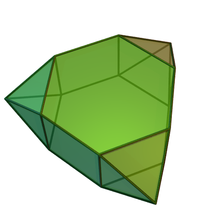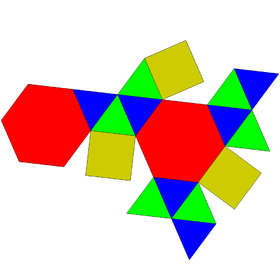
In geometry, the triaugmented triangular prism, tetracaidecadeltahedron, or tetrakis triangular prism is one of the Johnson solids (J51). Each of its 14 faces is an equilateral triangle, making it a deltahedron. As the name suggests, it can be constructed by attaching equilateral square pyramids (J1) to each of the three equatorial faces of the triangular prism.

In geometry, the triangular cupola is one of the Johnson solids (J3). It can be seen as half a cuboctahedron.

In geometry, the square orthobicupola is one of the Johnson solids (J28). As the name suggests, it can be constructed by joining two square cupolae (J4) along their octagonal bases, matching like faces. A 45-degree rotation of one cupola before the joining yields a square gyrobicupola (J29).

In geometry, the biaugmented triangular prism is one of the Johnson solids (J50). As the name suggests, it can be constructed by augmenting a triangular prism by attaching square pyramids (J1) to two of its equatorial faces.

In geometry, the biaugmented pentagonal prism is one of the Johnson solids (J53). As the name suggests, it can be constructed by doubly augmenting a pentagonal prism by attaching square pyramids (J1) to two of its nonadjacent equatorial faces.

In geometry, the augmented hexagonal prism is one of the Johnson solids (J54). As the name suggests, it can be constructed by augmenting a hexagonal prism by attaching a square pyramid (J1) to one of its equatorial faces. When two or three such pyramids are attached, the result may be a parabiaugmented hexagonal prism, a metabiaugmented hexagonal prism or a triaugmented hexagonal prism.

In geometry, the parabiaugmented hexagonal prism is one of the Johnson solids (J55). As the name suggests, it can be constructed by doubly augmenting a hexagonal prism by attaching square pyramids (J1) to two of its nonadjacent, parallel (opposite) equatorial faces. Attaching the pyramids to nonadjacent, nonparallel equatorial faces yields a metabiaugmented hexagonal prism.

In geometry, the metabiaugmented hexagonal prism is one of the Johnson solids (J56). As the name suggests, it can be constructed by doubly augmenting a hexagonal prism by attaching square pyramids (J1) to two of its nonadjacent, nonparallel equatorial faces. Attaching the pyramids to opposite equatorial faces yields a parabiaugmented hexagonal prism.

In geometry, the augmented dodecahedron is one of the Johnson solids (J58), consisting of a dodecahedron with a pentagonal pyramid (J2) attached to one of the faces. When two or three such pyramids are attached, the result may be a parabiaugmented dodecahedron, a metabiaugmented dodecahedron or a triaugmented dodecahedron.

In geometry, the parabiaugmented dodecahedron is one of the Johnson solids (J59). It can be seen as a dodecahedron with two pentagonal pyramids (J2) attached to opposite faces. When pyramids are attached to a dodecahedron in other ways, they may result in an augmented dodecahedron, a metabiaugmented dodecahedron, a triaugmented dodecahedron, or even a pentakis dodecahedron if the faces are made to be irregular.

In geometry, the metabiaugmented dodecahedron is one of the Johnson solids (J60). It can be viewed as a dodecahedron with two pentagonal pyramids (J2) attached to two faces that are separated by one face. When pyramids are attached to a dodecahedron in other ways, they may result in an augmented dodecahedron, a parabiaugmented dodecahedron, a triaugmented dodecahedron, or even a pentakis dodecahedron if the faces are made to be irregular.

In geometry, the triaugmented dodecahedron is one of the Johnson solids (J61). It can be seen as a dodecahedron with three pentagonal pyramids (J2) attached to nonadjacent faces.

In geometry, the elongated triangular cupola is one of the Johnson solids (J18). As the name suggests, it can be constructed by elongating a triangular cupola (J3) by attaching a hexagonal prism to its base.
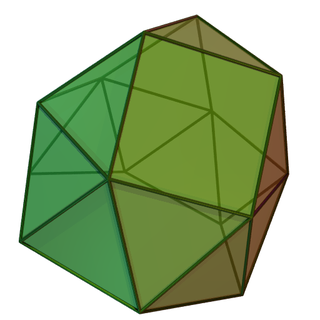
In geometry, the gyroelongated triangular cupola is one of the Johnson solids (J22). It can be constructed by attaching a hexagonal antiprism to the base of a triangular cupola (J3). This is called "gyroelongation", which means that an antiprism is joined to the base of a solid, or between the bases of more than one solid.

In geometry, the elongated triangular orthobicupola or cantellated triangular prism is one of the Johnson solids (J35). As the name suggests, it can be constructed by elongating a triangular orthobicupola (J27) by inserting a hexagonal prism between its two halves. The resulting solid is superficially similar to the rhombicuboctahedron, with the difference that it has threefold rotational symmetry about its axis instead of fourfold symmetry.
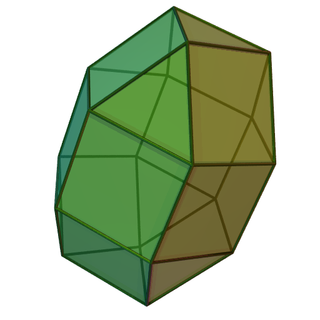
In geometry, the elongated triangular gyrobicupola is one of the Johnson solids (J36). As the name suggests, it can be constructed by elongating a "triangular gyrobicupola," or cuboctahedron, by inserting a hexagonal prism between its two halves, which are congruent triangular cupolae (J3). Rotating one of the cupolae through 60 degrees before the elongation yields the triangular orthobicupola (J35).

In geometry, the gyroelongated triangular bicupola is one of the Johnson solids (J44). As the name suggests, it can be constructed by gyroelongating a triangular bicupola by inserting a hexagonal antiprism between its congruent halves.

In geometry, the augmented truncated tetrahedron is one of the Johnson solids (J65). It is created by attaching a triangular cupola (J3) to one hexagonal face of a truncated tetrahedron.
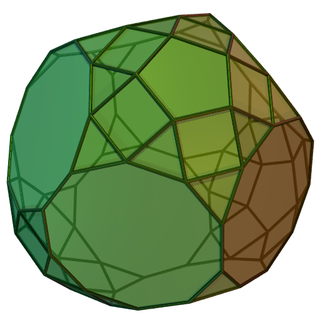
In geometry, the triaugmented truncated dodecahedron is one of the Johnson solids (J71); of them, it has the greatest volume in proportion to the cube of the side length. As its name suggests, it is created by attaching three pentagonal cupolas (J5) onto three nonadjacent decagonal faces of a truncated dodecahedron.
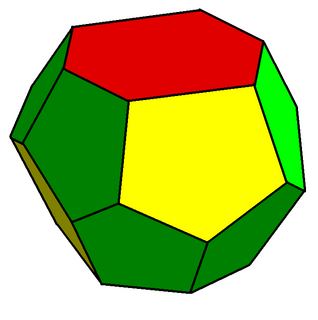
A tetradecahedron is a polyhedron with 14 faces. There are numerous topologically distinct forms of a tetradecahedron, with many constructible entirely with regular polygon faces.
